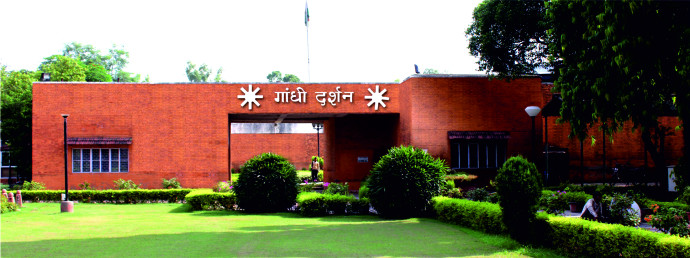The second campus is situated adjacent to the Mahatma Gandhi Samadhi at Rajghat.
It was twenty-one years after the Mahatma’s martyrdom that the whole world decided to observe his centenary in 1969 in a way worthy of the Pilgrim of Peace. It was then the sprawling thirty-six-acre campus came into existence to mark the centenary of Mahatma Gandhi. Thirteen Indian states and seven foreign countries had joined hands in creating the magic, called the Gandhi Darshan International Exhibition. The main objective of the exhibition was the interpretation of Gandhi’s message and the gospel of truth and non-violence against the background of the modern world and the way it has permeated and affected the nation’s life and influenced the other countries of the modern world.

Today two exhibitions exist in Gandhi Darshan- My Life is My Message and Freedom Struggle in clay models.
In the first pavilion entitled My Life is My Message, hundreds of archival photographs have been arranged on the walls, along with brief textual narratives. Some of these images of Gandhiji as a child and young man are rarely seen. There is also a model of the house in which he was born, as well as the actual army vehicle in which his body was transported for cremation to the grounds, now known as Rajghat.

In addition, visitors can see Gandhiji’s school report cards, newspaper clippings and cartoons that show contemporary reports and reviews of his activities, the letters exchanged between Gandhiji and Leo Tolstoy, portraits of his wife and parents and other fascinating material. One display showcases the many commemorative stamps issued by countries around the world in the years that followed Gandhiji’s assassination, and another displays the letters that were sent to him.
These, especially, reveal, how widespread was the fame that a simple Gujarati lawyer acquired in his lifetime. For example, one is addressed to ‘Gandhiji: Wherever He May Be’; another (posted in New York) simply has a sketch of Gandhiji on the envelope.
To summarize, this pavilion with 274 panels has the following:
- In Panel no. 1-273 there are photographs on the life of Gandhiji from birth till assassination, there are 1600 photographs approximately.
- In Panel no. 274 there are 75 stamps from different countries, released on the centenary year of Mahatma Gandhi.
- There are the boat and bench used during Salt Satyagraha and Gun Carriage which carried the mortal remains of Mahatma Gandhi from Birla House to Rajghat.
- There are models of:
- Gandhiji’s house at Porbandar in Gujarat
- Sabarmati Ashram
- Yervada Jail


The pavilion on Freedom Struggle comprises of beautiful clay models on different aspects of the freedom movement.
In 1994, during the 125th Birth Anniversary of Gandhiji, while addressing the nation Prime Minister Shri P. V. Narasimha Rao formally announced the setting up of International Centre of Gandhian Studies at Gandhi Darshan, Rajghat. On January 30, 2000, President K. R. Narayanan unveiled a Column declaring the entire Campus as the International Centre of Gandhian Studies and Peace Research in the presence of Prime Minister and Chairman of the GSDS, Shri Atal Bihari Vajpayee and several other dignitaries.












